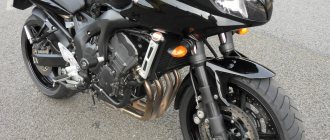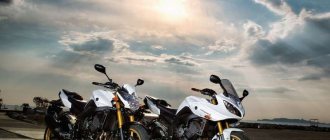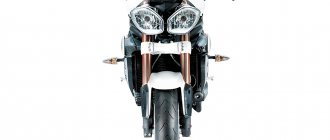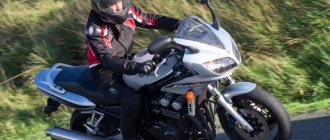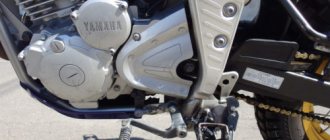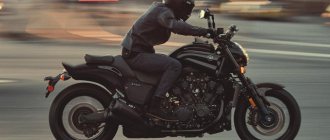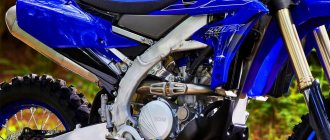- motorcycle model, Yamaha brand
The Yamaha FZR 750 Genesis sports motorcycle model was first introduced in 1987 and existed until 1989. The appearance of the model was due to Yamaha’s desire to have on the sports motorcycle market a medium-sized model, between 600 and 1000 cc, with better dynamics (than the 600) and less weight and size (than the “liter”). This is how the Yamaha FZR 750 model with the Genesis engine arose, which became the progenitor of the penultimate model in the class of 750 cc sports motorcycles, the Yamaha YZF 750.
The main feature of the Yamaha FZR 750 is its liquid-cooled inline 4-cylinder engine that produces 102 hp. power and 62 Nm of torque. The engine has 5 valves per cylinder and produces maximum performance at 8000-10000 rpm. Other key features of the model are an aluminum frame, 6-speed gearbox, fully adjustable suspension, conventional telescopic forks and an 18″ rear wheel.
Bike features
Here are the main features of the Yamaha FZR 750 Genesis:
- more powerful than the “six hundredth”, but more compact than the “liter”;
- ease of landing, despite the sports class;
- magnificent, hurricane dynamics, so many have not appreciated.
The motorcycle turned out great, no matter what anyone says. This model is the quintessence of everything a good sports bike needs. The Yamaha FZR 750 Genesis is perfect for racing on race tracks, but is also capable of leisurely riding.
Brief history of the model
1987 - start of production and sales. Model: Yamaha FZR750 (Japan, USA). Factory designation: FZR750RT.
1988 - no significant changes. Model: Yamaha FZR750 (Japan, USA, Europe). Factory designation: FZR750RU, 3CU1, 2YJ1, 3CS2.
1989 - appearance of the Yamaha FZR750R modification. Model: Yamaha FZR750; Yamaha FZR750R (Japan, USA, Europe). Factory designation: FZR750RW, 3PH1, 3JV1, 3SJ1, 3SG1, 3PK1, 3PJ1, 3PG1.
1990 is the last year of production. Model: Yamaha FZR750; Yamaha FZR750R (Japan, Europe). Factory designation: 3SJ2, 3SG2, 3PK2, 3PJ2, 3PG2, 3JV3.
Dimensions and weight
Without fuel, this motorcycle weighs only 213 kg - not that much, just average. The gas tank capacity reaches 20 liters, and taking into account the average consumption of about 6 liters per hundred kilometers, this is more than enough.
As for the dimensions, they are typical for a classic sports motorcycle and occupy a middle position between compact versions and giant representatives of the class.
Phaser: a moment of history
The Yamaha FZX 750 was produced from 1986 to 2000 , but the first generation is considered the most canonical, the last representatives of which rolled off the assembly line in 1990. It featured a more powerful engine ( 96 hp in European versions and 77 in Japanese) and 6-speed transmission, but the peak torque for the “Europeans” was reached only at 8000 rpm , and for the “Japanese” - at 6000 rpm min . Monstrous acceleration dynamics combined with the simplicity and reliability of the design gave the first generation Yamaha FZX 750 the status of a cult motorcycle.
Starting in 1990 , minor changes were made to the design - the engine was “ strangled ,” the gearbox was changed to a 5-speed , and in general they tried to turn the dragster into a road bike. It should be noted that representatives of the second generation, adjusted to Japanese standards, can easily compete with sports motorcycles on the road, but, nevertheless, it is the first “Phasers” that are still loved by enthusiasts. For obvious reasons, finding such a bike in good condition is problematic - they are all thirty years old, give or take.
Chassis and brakes
The suspensions, both rear and front, are equipped with all adjustments. The motorcycle brakes from the rear using a disc with a diameter of 267 mm. This disc is assisted by a two-piston caliper. At the front, the brakes are a pair of discs, each with a diameter of 320 mm, but they are still supported by two-piston calipers, which some will consider a minus.
The frame is made of aluminum. Considering that the bike was not too light, this was the right decision on Yamaha's part. In general, the exterior, although bright, is unobtrusive, which will please those who cannot stand intrusiveness and deliberateness.
Characteristics:
Specifications of Yamaha FZR750/FZR750R:
| Model | Yamaha FZR750 |
| Motorcycle type | sport |
| Year of issue | 1987-1990 |
| Frame | aluminum |
| engine's type | 4-cylinder, 4-stroke, in-line |
| Working volume | 749 cm³ |
| Bore/Stroke | 68.0 x 51.6 mm – FZR750 72.0 x 46.0 mm – FZR750R |
| Compression ratio | 11,2:1 |
| Cooling | liquid |
| Number of valves per cylinder | DOHC, 5 valves per cylinder |
| Fuel supply system | Carburetor, 4x 34 mm – FZR750 Carburetor, 4x Mikuni BDST38 – FZR750R |
| Ignition type | TCI |
| Maximum power | 106.0 hp (78.0 kW) at 10500 rpm – FZR750 121.0 hp (89.0 kW) at 12000 rpm – FZR750R 77.0 hp (56.5 kW) at 10500 rpm – FZR750/FZR750R (Japan) |
| Maximum torque | 72.0 Nm (7.3 kg*m) at 8250 rpm – FZR750 70.0 Nm (7.1 kg*m) / 9000 rpm – FZR750R |
| Clutch | Multi-disc in an oil bath, hydraulic drive - until 1989. Multi-disc in an oil bath, cable drive - since 1989. |
| Transmission | 6-speed |
| type of drive | chain |
| Front tire size | 120/70-ZR17 |
| Rear tire size | 160/60 VR18 – FZR750 170/60-ZR17 – FZR750R |
| Front brakes | 2 discs, 320 mm, 2-piston calipers – FZR750 2 discs, 280 mm, 4-piston calipers – FZR750R |
| Rear brakes | 1 disc 267 mm, 2-piston caliper |
| Front suspension | 41mm telescopic fork (fully adjustable) – FZR750 43mm telescopic fork (fully adjustable) – FZR750R |
| Rear suspension | Pendulum with KYB monoshock absorber (fully adjustable) – FZR750 Pendulum with Öhlins monoshock absorber (fully adjustable) – FZR750R |
| Length | 2125 mm – FZR750 2100 mm – FZR750R |
| Width | 730 mm – FZR750 705 mm – FZR750R |
| Height | 1215 mm – FZR750 1160 mm – FZR750R |
| Wheelbase | |
| Minimum ground clearance (clearance) | |
| Seat height | |
| Acceleration 0-100 km/h (0-60 mph) | 3.3 sec. |
| Maximum speed | 240 km/h – FZR750 257 km/h – FZR750R |
| Gas tank capacity | 20.0 l – FZR750 23.0 l – FZR750R |
| Motorcycle weight (dry) | 203 kg – FZR750 187 kg – FZR750R |
Pros and cons of the Yamaha FZX 750 Fazer
Advantages
- Crazy acceleration dynamics. When the gas is sharply opened, the motorcycle literally jumps out from under the pilot, trying to move towards the horizon in a matter of seconds. The Yamaha FZX 750 can easily leave many modern bikes in the dust.
- Decent brakes. In those years, of course, no one had heard of combined braking systems and ABS, but for such an old motorcycle, the brakes on the Yamaha FZX 750 are really quite good.
- Comfortable fit. Thanks to thoughtful ergonomics and moderately compact dimensions, the Yamaha FZH 750 is suitable for most bikers.
- 6-speed transmission (first generation). On long trips, according to reviews, it allows you to save a lot of fuel if you don’t drive too fast.
- Vitality. The simple design of the FZH 750 is distinguished by its reliability and ease of repair; it can be serviced in the garage, and repaired on the knee. If you take good care of it, it will serve faithfully for a very long time.
Flaws
- Wind protection. The FZX 750 does not have it, from the word “at all,” so the headwind begins to blow away from the motorcycle already at 130-140 km/h.
- Fuel consumption. The consumption declared by the Japanese when releasing this motorcycle was about 2.4 liters (!) per 100 mph. It is not known exactly how they measured it, but on average, real gasoline consumption ranges from 5.5 (with quiet driving on the highway) to 10 liters of AI-92 (city traffic jams, crazy runs on the highway at speeds under 200 km/h).
- Small gas tank capacity - only 13 liters .
- Valency. It’s not easy to control a motorcycle at low speeds—it reacts very sharply to opening the gas, and also regularly tries to fall on its side in a turn. But once you reach at least 30 km/h, this drawback goes away.
- Headlight. It shines weakly, but replacing the bulb with a more powerful one helps somewhat.
13.05.2003
For many years now, motorcycle manufacturers have been vying to create the best 600cc sports bike. The demand for these machines, which over time become not only faster, but also better, forces manufacturers to constantly modernize and improve each model... Nowadays, it is rare for any manufacturer of leading brands to leave their 600 cc sports motorcycle for more than three years without major modifications centimeters. While manufacturers have excelled in producing these wonderful motorcycles, advances in technology have led to high prices, some of which have now reached $8,200.
Now these top tier 600cc motorcycles are beyond the reach of most buyers, especially college students. And motorcycle manufacturers have even decided to finance their frugal, no-savings lifestyle in the hope that things will change later, in a few years, which is why a low down payment is often the main factor when buying a new motorcycle.
Check out this fast, mid-weight sports bike with a fairly reasonable price. It's not that expensive, you might think, and it was nice for them to have it. Therefore, we decided to introduce you to the class of 600 cc sports motorcycles, with two of its representatives - the Yamaha FZR600 and the Suzuki Katana 600.
One of the famous Americans said, describing the philosophy of the Katana and FZR: “If it doesn’t break, then don’t touch it!” This is what both of these motorcycles are remembered for, and their design has remained virtually unchanged since the late 1980s. By saving money on scientific research, as well as on modernizing production, Yamaha and Suzuki were able to reduce production costs, which naturally led to lower prices.
The Suzuki Katana has a simple instrument panel consisting of a large, easy-to-read speedometer, tachometer and fuel gauge. The Yamaha FZR shows its sporting level by having its own tachometer and temperature scales separate from the speedometer. But how much cheaper have they become? The 1997 Suzuki Katana retailed for $6,099, or $1,600 less than the new GSX-R600. And the Yamaha FZR600 costs $6,499, which is $900 less than its little brother, the 1997 YZF600R.
Obviously, a 600cc machine will cost a lot less than high-end sports bikes, but how much should you pay for this bike? Back in the eighties, both the FZR and Katana were competitive machines, but today neither can compete with modern 600-class motorcycles in any category. However, in the real world, both lap times and stopwatch times are not the same are important, but what's more important is that they can get you to class or to the office on time, which is more necessary in everyday life, and both cars can do this while giving you the pleasure of free movement on the road. Whether it's outdated technology or a lackluster ride, riding any of these bikes will still raise your pulse and be a lot of fun.
But how can these motorcycles be compared? Which one works better? After all, both cars have the limited capabilities of a linear four-cylinder engine configuration, but if you directly compare the results of driving on the ring, the FZR will be ahead in comparison with the Katana.
The Yamaha has more power at the higher end of the engine spec and is weaker than the Suzuki engine, pulling over a wider rpm range. But even the dynamic performance shows that the FZR has a few more horsepower than the Suzuki, and it weighs noticeably less, which obviously helps with better acceleration.
This combination of superior power with two-point braking, light weight and a narrow cockpit makes the FZR easy to hop on and go fast. Our only concern was the clunky gearing and the yaw of the rear suspension. And installing a new aftermarket rear shock could greatly improve the rear suspension.
Suzuki is a completely different story. Its extra weight, combined with poor cornering performance, thanks in part to Suzuki's choice of Metzeler Laser front tires, makes the inexperienced rider uneasy at high speeds. Often the Katana requires extra steering effort to finish a curve smoothly compared to the FZR.
The Katana would also benefit from modifications aimed at reducing handling effort. Some effect can be achieved by extending the fork tubes a few millimeters at the fork mounting point, which will reduce the effort required to turn the motorcycle. Other tires with a different, more triangle-shaped profile would also help. Around town, the Katana shines with its wide seat, light clutch, tall handlebars, and compliant suspension that make for a very enjoyable ride.
The brakes on the Yamaha FZR are excellent, providing great stopping power and excellent feedback. The Katana's brakes lack smoothness and power. Each of the bikes is very capable on a twisty road, but they're just as exciting in the monetary department, with every effort put into affordability on the FZR600 and Katana. Suzuki's offer is better because the purchase of a new Katana 600 requires zero down payment and a financing rate of 14.90 percent. And Yamaha requires a minimum down payment of $750 and a credit financing rate of 18.00 percent to purchase the FZR 600.
With a 60-month payment plan, the Katana will cost $166.69 per month versus $170.48 for the FZR. Also note that buyers can save significant money by locating a dealership that still has remnants of 1996 models that only have a different paint scheme.
In the US, when purchasing a new motorcycle, full insurance coverage is required and the associated additional costs are at your discretion. Relative to the 600cc class, this insurance is inexpensive because motorcycle rates are based on weight and location. At California State Farm Insurance Agency, the total cost of insurance is $133.81 per month for any motorcycle. But the price of insurance can be reduced to $33.30 per month if your car policy is issued through this agency and you have been insured with it for 10 years or more.
Obviously, the costs of financing and full insurance add significantly to the final price of any motorcycle. And purchasing the FZR with a $750 down payment plus interest would bring its total final cost to a very high $10,978, which is almost a thousand dollars more than the $10,001 you'll pay for the Katana! But that doesn't even include the insurance amount, which, with a full credit program over a 60-month period, can reach an equally high value of $8,028. But while not many of us are able to buy a motorcycle outright, we can save more by purchasing a motorcycle in installments.
Another, no less important point, if you have a tight budget, is the cost of spare parts. In the event of an accident, restoring a full fairing motorcycle is very expensive. On most sport bikes, the upper fairing, lower fairing, tail section and gas tank parts are interlocking and therefore subject to damage in a typical drop-over collision. Replacing these parts on a Yamaha would cost you, or your insurance company, $1,600 versus $1,900 on a Suzuki.
While new riders and those who love a smooth, streamlined style might choose the Suzuki Katana, most people will prefer the FZR. The Yamaha FZR 600 is a joy to ride, giving you complete safety even at high speeds. And when driving around the city, the FZR is straight and light, making it easier to maneuver in city traffic. Its ergonomics are very respectable for a sportsbike, and are well suited for planning 300-mile weekend trips.
Of course, these motorcycles may not provide you with the leading technology, but you do get reliable equipment that the budget of most of us, hungry students and new riders can handle. If you don't need the trickiest, fastest, newest model, then any of the 600 class motorcycles will satisfy your requirements as a good and reliable city bike.
Travel impressions
:
1. Brent Plummer, Editor-in-Chief
A crisp winter day dawned in Los Angeles, filling it with bright sunshine. A hard left, then a hard right, the FZR takes these corners really quickly and has plenty of power to spare. As you twist the throttle to a stop and gradually descend the incline, you realize how difficult it is to descend safely on the brakes on a 400-pound motorcycle. “A little more than six degrees,” I think to myself, “that’s not bad at all.”
And then, when the excitement of the canyon wears off, I have to make the 25-mile trek back to the MO office. Five miles down the road, my wrists are completely exhausted, and my opinion of directional stability is destroyed: “Understanding the majority of people interested in this bike and paying for it, they still want to know, is this bike really worth a thousand dollars more than the Katana? »
The answer, at least to the senior members of our firm's staff, is obvious. In this test we were clearly divided by age with the younger part of our firm outnumbering the old guard. And there is only one answer - “No”.
I don't like to ride down on the road and in pain, so the Katana's good seat, high bars and low pegs make this bike a clear winner in my book.
2. Sean Hijby, technical writer
Reliability is my number one priority, whether I'm driving on the streets or on the highway. The most rewarding thing is when the bike is predictable and requires little effort when moving, that's when it gives me a feeling of complete control. The narrow cockpit, light weight, and quick and easy handling make the FZR600 feel like a toy motorcycle.
Within minutes of starting the ride, I felt confident pushing the FZR to its limits. I was able to get the FZR back into the corner quickly and spin the wheel out just as quickly. The chassis is light and turns quickly, and seems to be constantly calling, “turn me!”
I've ridden both the FZR and the Katana several times in a row, and this has further solidified my choice in favor of the FZR. After riding the Suzuki Katana for several weeks, I became accustomed to its features and was able to accept it as a city bike. But when I switched back to the FZR again, I came to the conclusion that Yamaha - “Oh... Wow!”
3. Billy Bartels, Graphics Editor
We had both of these two bikes at the same time for a while. At the end of the summer I rode them both non-stop and grew with them. And then I switched to the Kawasaki ZX-6 and Buell Cyclone to review them.
When I switched back to the Katana a month later, I thought someone had decided to let the air out of the tires. It was a difficult and thankless comparison. To clarify the differences, I drove the FZR the next day and was pleasantly surprised by its lightness and reasonable comfort. I went back and forth many times to make sure, and I was completely exhausted by the comparison. No, I genuinely like the FZR and don't like driving the Katana at all.
Katana has a low price, which speaks in its favor, but, unfortunately, this is also an indicator of quality. In addition to the handling shortcomings, there is also a whirring noise right at the top of the power curve, but it's not a big part of the curve, and the gearbox sometimes jumps out under high acceleration. By the way, it's also hard.
However, the FZR is by no means presented as a clear winner. Its seat is useless if you weigh more than 180 pounds, or are carrying a backpack (which I've learned myself is not an easy feat). The drive is oversized, which sometimes forces the suspension to unload when cornering (and it's not fun).
The view in the rearview mirrors is also limited, as if you were looking through the hub. But other than those little quirks, it's a small and very capable bike. Faster and better control in one package justifies the significant price difference.
4. Gord Mounce, Associate Editor
While these 600cc cars are in the same category, they have very different personalities. The Katana is user friendly and built like a big street bike. However, when acceleration and energetic cornering are required, the slow turning speed and added weight of the car limit the fun.
The Yamaha FZR is not so light that jumping on it will immediately feel like being on a motorcycle that you have known for a long time, but at the same time it is just as comfortable as the Katana. But once you put a few miles on the bike, the FZR's chassis starts to inspire you, cutting corners at speeds that wouldn't be possible on a Catana. For me, owning a sports bike is everything. FZR gets my vote.
5. Tom Fortune, Managing Editor
Numbers make it possible to compare. And in this comparison, those numbers equal dollars. I prefer to have dollars in my pocket. And this is the whole point of this story, as it is supposed to find out which of the motorcycles actually represents the greatest value, valued in dollars, isn't it? And with zero down payment plus a $400 lower purchase price on the motorcycle, the Katana is my choice.
For the money I'd save, I'd be able to live with the shortcomings of the little Kata, which really isn't that bad. But on a winding country road, I thought that this steering actually turned out to be a rather pleasant curse.
Indeed, you wouldn't notice any handling quirks at all unless you switched from the Katana to the FZR, and then returned to the Katana again. It's only then that its high weight and slow handling seem wrong. And for taller riders like me, the Suzuki was more comfortable than the FZR with its boyish, race-inspired ergonomics.
But I'm not confident enough to say with certainty which bike has more horsepower or can make a turn faster. But if you go to buy one of them, remember that the Katana is very user friendly, which is an important fact for a budding motorcyclist, and represents the best option in terms of budget purchase.
Owner reviews
Before purchasing, I read reviews about the Yamaha FZH 750, people are generally satisfied. The prices for this model are low due to its antiquity; you can buy it for the same money as some 400 seabird, which didn’t even stand next to the Phaser. Yes, the bike is old, with all the ensuing consequences, but it’s reliable as a brick, and there are no problems with spare parts; many things fit from other models. It accelerates like a rocket, it consumes gas like crazy, although I may not be objective here, because... My carbs are not original, and I don’t know what’s in them. In general, a really crazy lighter for little money. Vadim, Moscow, Yamaha FZX '1988.
I was inspired to buy this motorcycle when I looked at a review of it on YouTube, although at that time there was already a Dragstar 1100 in the garage. I ended up taking it from a friend for 110k, 1990, 60k mileage on the odometer (but that’s not certain). Over the course of a month, I tidied up the little things, rode either it or the Drag, depending on my mood. This motorcycle is designed to rock, I think most owners will agree with me here. I drove it for a year, got hooked, sold it, bought a V-Max 1200 from the last year of production. The same as FZH 750, only better. Alexander, Novosibirsk, Yamaha FZX 750 '1990
The Phaser has two disadvantages - age and gas tank volume, the rest are pure advantages. If you find a non-killed copy, it will serve faithfully, all consumables are there, spare parts can be found. A bike for centuries, they don’t make them like that anymore. Ilya, Moscow, Yamaha FZX 750 '1994.
